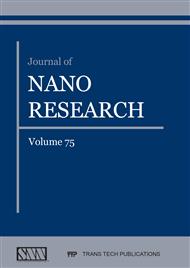p.17
p.29
p.41
p.59
p.71
p.81
p.99
p.121
p.139
Electrolyte-Dependent Capacitance of Titanium Dioxide Nanotube Array Electrode Substrate
Abstract:
The anatase titanium dioxide nanotube array (TiO2 NTA) with short and independent nanotube film structure is applied as stable metal oxide electrode substrate. The influence of different proton acid electrolytes is fully investigated on the electrical double-layer capacitance. The anatase TiO2 NTA electrode substrate conducts reversible protonation-deprotonation process of dissociation hydrogen ion and electrostatic adsorption-desorption process of equilibrium anion in the cycling charge-discharge process. The reversible properties could be well proved by highly symmetric characteristic of positive-negative sweeping current and charge-discharge potential. The protonated TiO2 NTA electrode substrate reveals cyclic voltammetry-based capacitances of 0.147 and 0.124 mF cm-2, galvanostatic charge-discharge-based capacitances of 0.167 and 0.148 mF cm-2 when similar dissociation proton concentration is maintained in 1.0 M H2SO4 and 1.0 M HCl. The TiO2/H2SO4 exhibits similar capacitance enhancement ratio of 1.19 and 1.13 in comparison with of the TiO2/HCl. The corresponding electrical double-layer capacitance at the same dissociation proton condition is mostly dependent on the electrostatic interaction between the protonated TiO2 and equilibrium anions in different proton acid electrolytes rather than anion diffusion. The theoretical simulation calculation reveals that TiOOH+-HSO4- shows lower interaction interface energy and higher total densities of states than TiOOH+-Cl-. Accordingly, TiO2/H2SO4 conducts more feasible protonation and electrostatic adsorption process rather than TiO2/HCl, contributing to its superior electrical double-layer capacitance.
Info:
Periodical:
Pages:
71-80
Citation:
Online since:
September 2022
Authors:
Price:
Сopyright:
© 2022 Trans Tech Publications Ltd. All Rights Reserved
Share:
Citation:


